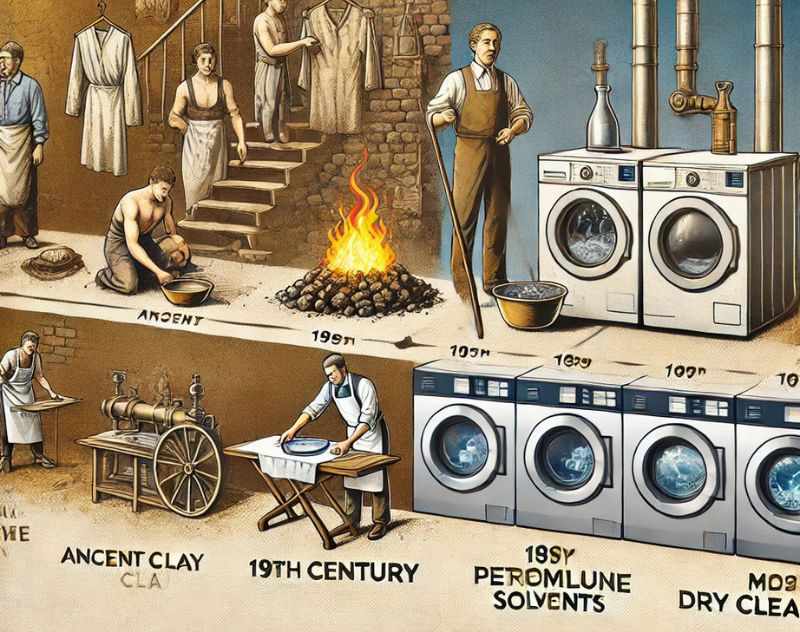
Dry cleaning is a process that has been around for centuries, evolving from rudimentary cleaning techniques to modern, high-tech solutions. But have you ever wondered how it all started? The history of dry cleaning is a tale of innovation, chemistry, and technological advancements. This blog will take you through the journey of dry cleaning, from its ancient roots to the sophisticated methods used today.
The Origins of Dry Cleaning: Ancient Beginnings
The history of dry cleaning dates back to ancient civilizations. The earliest records suggest that the Romans and Greeks used a form of dry cleaning for their woolen garments. They employed a mixture of ammonia and clay to remove fabric stains and odors. Roman fullers, the early equivalents of modern dry cleaners in Dwarka Sector 12, used a special type of clay called "fuller's earth" to absorb grease and dirt.
As time progressed, different cultures experimented with unique cleaning techniques. In the Middle Ages, people relied on natural solvents like turpentine and spirits to clean delicate fabrics. However, these methods were not always effective and often damaged the textiles.
The 19th Century: The Birth of Modern Dry Cleaning
The modern history of dry cleaning can be traced to the early 19th century. One of the most famous stories involves Jean-Baptiste Jolly, a French dyeworker. According to legend, Jolly discovered the cleaning power of petroleum-based solvents when his maid accidentally spilled kerosene on a stained tablecloth. Instead of leaving a mark, the kerosene effectively removed the stain, leading Jolly to experiment further. By 1825, he had opened the first commercial dry cleaning shop in France.
Around the same time, Thomas Jennings, an African American inventor in the United States, developed an early dry cleaning method called "dry scouring." Jennings received a patent for his process in 1821, making him a pioneer in the industry. His work laid the foundation for the dry cleaning services we use today.
The Rise of Petroleum-Based Solvents
During the late 19th and early 20th centuries, dry cleaning became more sophisticated. Early dry cleaners primarily used petroleum-based solvents like kerosene and gasoline to remove stains. While effective, these solvents were highly flammable, posing serious safety hazards.
The demand for safer alternatives led to the discovery of chlorinated solvents. In the 1930s, perchloroethylene (commonly known as "perc") became the preferred cleaning agent. Perc was less flammable and more efficient at breaking down grease and oils, revolutionizing the history of dry cleaning. To this day, many dry cleaners, including dry cleaners in Dwarka Sector 12, continue to use perc in their cleaning processes.
The Environmental Shift: Green Dry Cleaning
As awareness about environmental and health concerns grew, dry cleaning methods had to adapt. Traditional solvents like perc raised concerns due to their toxicity and potential health risks. This led to the rise of eco-friendly dry cleaning alternatives in the late 20th and early 21st centuries.
Some of the most notable green dry cleaning methods include:
Wet Cleaning: A water-based method that uses specialized detergents and machines to clean delicate fabrics without damage.
Liquid CO2 Cleaning: A process that uses liquid carbon dioxide as a solvent, leaving no toxic residues.
Silicone-Based Solvents: These are derived from sand and are non-toxic, making them a safer alternative to traditional solvents.
Many dry cleaners in Dwarka Sector 12 and across the world have embraced these sustainable practices to reduce their environmental impact.
The Role of Technology in Modern Dry Cleaning
Technology continues to shape the history of dry cleaning, making it more efficient and accessible. Some of the latest advancements include:
Automated Cleaning Machines: These machines optimize solvent usage and reduce waste.
Barcode Tracking Systems: They ensure garments are handled correctly throughout the cleaning process.
Smartphone Apps for Scheduling Pickups and Deliveries: Customers can now schedule dry cleaning services with the tap of a button.
These innovations not only improve service quality but also enhance customer convenience, a key factor in the growing dry cleaning industry.
The Future of Dry Cleaning
As technology and sustainability continue to evolve, the future of dry cleaning looks promising. Researchers are exploring bio-based solvents and advanced filtration systems to make dry cleaning even greener. Additionally, artificial intelligence (AI) and machine learning are being integrated to automate stain removal and fabric care analysis.
With continuous improvements, dry cleaners in Dwarka Sector 12 and worldwide are expected to provide more efficient and environmentally responsible services.
Conclusion
The history of dry cleaning is a testament to human ingenuity and progress. From ancient cleaning techniques to modern eco-friendly solutions, dry cleaning has come a long way. Today, advanced technologies and sustainable practices are shaping the industry, ensuring that dry cleaning remains an essential service for years to come.
Whether you're interested in historical cleaning methods or looking for modern, high-quality dry cleaning, understanding its fascinating journey gives you a new appreciation for this essential service.










Write a comment ...